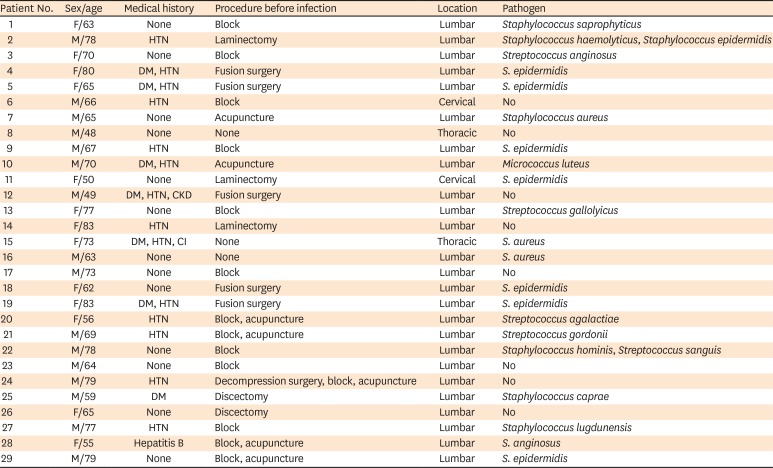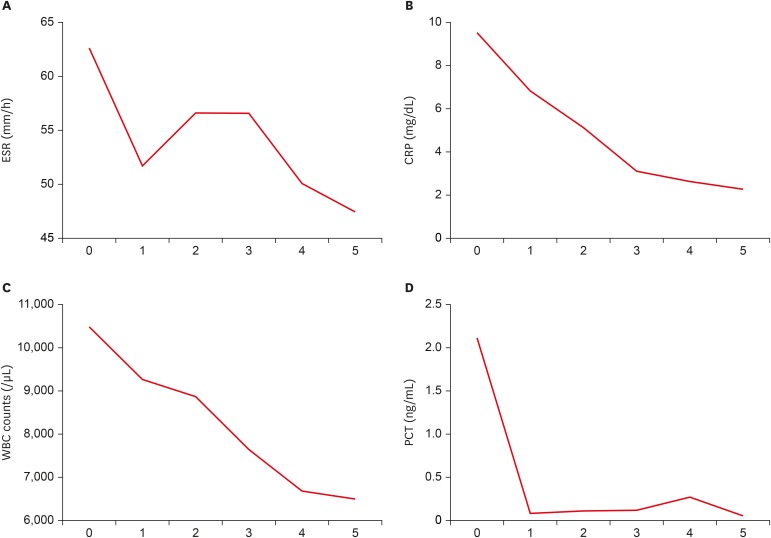1. Becker KL, Snider R, Nylen ES. Procalcitonin in sepsis and systemic inflammation: a harmful biomarker and a therapeutic target. Br J Pharmacol. 2010; 159:253–264. PMID:
20002097.

2. Branche A, Neeser O, Mueller B, Schuetz P. Procalcitonin to guide antibiotic decision making. Curr Opin Infect Dis. 2019; 32:130–135. PMID:
30648993.

3. Bustamante A, Vilar-Bergua A, Guettier S, Sánchez-Poblet J, García-Berrocoso T, Giralt D, et al. C-reactive protein in the detection of post-stroke infections: systematic review and individual participant data analysis. J Neurochem. 2017; 141:305–314. PMID:
28171699.

4. Choi MK, Kim SB, Kim KD, Ament JD. Sequential changes of plasma C-reactive protein, erythrocyte sedimentation rate and white blood cell count in spine surgery: comparison between lumbar open discectomy and posterior lumbar interbody fusion. J Korean Neurosurg Soc. 2014; 56:218–223. PMID:
25368764.
5. Chung YG, Won YS, Kwon YJ, Shin HC, Choi CS, Yeom JS. Comparison of serum CRP and procalcitonin in patients after spine surgery. J Korean Neurosurg Soc. 2011; 49:43–48. PMID:
21494362.

6. Dapunt U, Bürkle C, Günther F, Pepke W, Hemmer S, Akbar M. Surgical site infections following instrumented stabilization of the spine. Ther Clin Risk Manag. 2017; 13:1239–1245. PMID:
29033574.

7. De Santis V, Corona A. Procalcitonin to guide antibiotic stewardship in intensive care. Lancet Infect Dis. 2016; 16:887–888. PMID:
27477972.

8. Dubost JJ, Lopez J, Pereira B, Couderc M, Tournadre A, Soubrier M. Serum procalcitonin measurement is not a useful biomarker in the detection of primary infectious spondylodiscitis. Joint Bone Spine. 2017; 84:503–504. PMID:
27659402.

9. Gilbert DN. Use of plasma procalcitonin levels as an adjunct to clinical microbiology. J Clin Microbiol. 2010; 48:2325–2329. PMID:
20421436.

10. Heim N, Wiedemeyer V, Reich RH, Martini M. The role of C-reactive protein and white blood cell count in the prediction of length of stay in hospital and severity of odontogenic abscess. J Craniomaxillofac Surg. 2018; 46:2220–2226. PMID:
30416035.

11. Jenkins TC, Haukoos JS, Cotton E, Weitzenkamp D, Frank DN, Burman WJ. Time course of C-reactive protein and procalcitonin levels during the treatment of acute bacterial skin infections. Open Forum Infect Dis. 2018; 5:ofy029. PMID:
29516022.

12. Jeong DK, Lee HW, Kwon YM. Clinical value of procalcitonin in patients with spinal infection. J Korean Neurosurg Soc. 2015; 58:271–275. PMID:
26539272.

13. Jeong SJ, Choi SW, Youm JY, Kim HW, Ha HG, Yi JS. Microbiology and epidemiology of infectious spinal disease. J Korean Neurosurg Soc. 2014; 56:21–27. PMID:
25289121.

14. Kang KT, Son DW, Lee SH, Song GS, Sung SK, Lee SW. Variation of C-reactive protein and white blood cell counts in spinal operation: primary fusion surgery versus revision fusion surgery. Korean J Spine. 2017; 14:66–70. PMID:
29017299.

15. Kunakornsawat S, Tungsiripat R, Putthiwara D, Piyakulkaew C, Pluemvitayaporn T, Pruttikul P, et al. Postoperative kinetics of C-reactive protein and erythrocyte sediment rate in one-, two-, and multilevel posterior spinal decompressions and instrumentations. Global Spine J. 2017; 7:448–451. PMID:
28811989.

16. Lener S, Hartmann S, Barbagallo GM, Certo F, Thomé C, Tschugg A. Management of spinal infection: a review of the literature. Acta Neurochir (Wien). 2018; 160:487–496. PMID:
29356895.

17. Maus U, Andereya S, Gravius S, Ohnsorge JA, Miltner O, Niedhart C. Procalcitonin (PCT) as diagnostic tool for the monitoring of spondylodiscitis. Z Orthop Unfall. 2009; 147:59–64. PMID:
19263315.
18. Mun JH, Kim DH, Ryu KS, Park CK, Kim MC. Diagnostic value of early inflammatory reaction in postoperative infection of the lumbar spine. J Korean Neurosurg Soc. 2005; 38:206–210.
19. Pull ter Gunne AF, Cohen DB. Incidence, prevalence, and analysis of risk factors for surgical site infection following adult spinal surgery. Spine. 2009; 34:1422–1428. PMID:
19478664.

20. Samsudin I, Vasikaran SD. Clinical Utility and Measurement of Procalcitonin. Clin Biochem Rev. 2017; 38:59–68. PMID:
29332972.
21. Schuetz P, Beishuizen A, Broyles M, Ferrer R, Gavazzi G, Gluck EH, et al. Procalcitonin (PCT)-guided antibiotic stewardship: an international experts consensus on optimized clinical use. Clin Chem Lab Med. 2019; 57:1308–1318. PMID:
30721141.

22. Shehabi Y, Seppelt I. Pro/Con debate: is procalcitonin useful for guiding antibiotic decision making in critically ill patients? Crit Care. 2008; 12:211. PMID:
18466649.

23. van der Geest PJ, Mohseni M, Linssen J, Duran S, de Jonge R, Groeneveld AB. The intensive care infection score - a novel marker for the prediction of infection and its severity. Crit Care. 2016; 20:180. PMID:
27384242.

24. Yoon YK, Jo YM, Kwon HH, Yoon HJ, Lee EJ, Park SY, et al. Differential diagnosis between tuberculous spondylodiscitis and pyogenic spontaneous spondylodiscitis: a multicenter descriptive and comparative study. Spine J. 2015; 15:1764–1771. PMID:
25862505.







 PDF
PDF ePub
ePub Citation
Citation Print
Print



 XML Download
XML Download